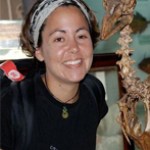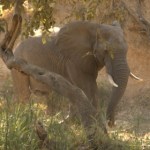ancient dna
We had a great discussion with John Hawks on the radio today. The podcast of that conversation is available via any one of the routes indicated here.
We discussed australopiths, Homo, Paleolithic sex, ancient DNA and fossil casting calls. And more. Check it out.
Thanks, John, for your time!
Meet Nifty Fifty evolutionary biologist Beth Shapiro who spends her days peering into the past. Her work in the emerging research field of ancient DNA takes her on a fascinating journey through time - collecting and studying the genetic samples of giant mammoths, saber-toothed cats, mastodons, dodo birds and other extinct animals, and piecing together such mysteries as the last ice age and the arrival of the first humans to North America.
"Ancient DNA gives us new insight into the most fundamental processes of evolution and refreshing new information about our past," says Beth, assistant…
Everyone knows that there are two kinds of elephants in this world: Asian and African. The Asian is the only one that can be trained and the African ones live in harmony with their environment until hunters come by and shoot them. Scratch a little deeper, and the African bush elephant lives by destroying its environment and moving on to new areas, where it destroys that environment, cycling back to the original region over generational time; Both African and Asian elephants can be trained; and there are three, not two species of elephant in this world: Asian, African Bush, and African…
Reviewed by other ScienceBloggers:
Prehistoric DNA reveals the story of a Pleistocene survivor, the muskox
Ancient DNA Isolated from Fossil Eggshells May Provide Clues to Eggstinction of Giant Birds
tags: evolution, evolutionary biology, ancient DNA, aDNA, molecular biology, molecular ecology, archaeology, paleontology, fossil eggshell, extinct birds, giant moa, Dinornis robustus, elephant birds, Aepyornis maximus, Mullerornis, Thunderbirds, Genyornis, researchblogging.org,peer-reviewed research, peer-reviewed paper, journal club
Elephant bird, Aepyornis maximus, egg
compared to a human hand with a hummingbird egg balanced on a fingertip.
To conduct my avian research, I've isolated and sequenced DNA from a variety of specimens, such as blood, muscle, skin and a variety of internal…
Even extinction and the passing of millennia are no barriers to clever geneticists. In the past few years, scientists have managed to sequence the complete genome of a prehistoric human and produced "first drafts" of the mammoth and Neanderthal genomes. More controversially, some groups have even recovered DNA from dinosaurs. Now, a variety of extinct birds join the ancient DNA club including the largest that ever lived - Aepyornis, the elephant bird.
In a first for palaeontology, Charlotte Oskam from Murdoch University, Perth, extracted DNA from 18 fossil eggshells, either directly…
A western Eurasian male is found in 2000-year-old elite Xiongnu cemetery in Northeast Mongolia:
We analyzed mitochondrial DNA (mtDNA), Y-chromosome single nucleotide polymorphisms (Y-SNP), and autosomal short tandem repeats (STR) of three skeletons found in a 2,000-year-old Xiongnu elite cemetery in Duurlig Nars of Northeast Mongolia. This study is one of the first reports of the detailed genetic analysis of ancient human remains using the three types of genetic markers. The DNA analyses revealed that one subject was an ancient male skeleton with maternal U2e1 and paternal R1a1 haplogroups.…
Olivia Judson has an interesting column up, Dawn at the Museum. Worth checking out since it talks about DNA extraction from specimens long deceased.
Dienekes points me to a new paper, Demographic history of Canary Islands male gene-pool: replacement of native lineages by European (PDF). Here are the results:
Autochthonous (E-M81) and prominent (E-M78 and J-M267) Berber Y-chromosome lineages were detected in the indigenous remains, confirming a North West African origin for their ancestors which confirms previous mitochondrial DNA results. However, in contrast with their female lineages, which have survived in the present-day population since the conquest with only a moderate decline, the male indigenous lineages have dropped constantly…
I'm guessing a lot of us have been waiting for John Hawks to comment in detail about the release of low-coverage sequencing of the Neanderthal genome - well, wait no longer.
Subscribe to Genetic Future.
Razib has an excellent discussion of a brand new paper in PLoS Genetics, which uses DNA samples from medieval Icelandic skeletons to explore the genetic history of the Icelandic population.
This population is of course of great interest to human geneticists: the Icelandic company deCODE (the home of over half the authors on this paper) has used its exclusive access to the DNA and genealogical and health records of Icelanders to publish vast numbers of studies on the genetic basis of human disease and other complex traits. In addition, deCODE's consumer genetics division deCODEme provides one…


